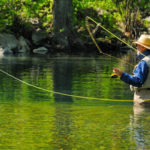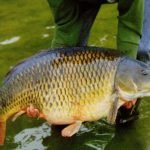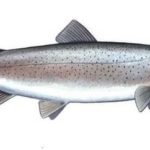 Sygnałem startowym do holu ryby jest zacięcie. Kto źle zacina, odpada w przedbiegach. Takie są reguły gry.
Sygnałem startowym do holu ryby jest zacięcie. Kto źle zacina, odpada w przedbiegach. Takie są reguły gry.
Pierwszym i jednocześnie najważniejszym momentem holu ryby jest jej umiejętne zacięcie. W przypadku pewnego wbicia haczyka w pysk ryby, tylko zerwanie żyłki może przesądzić o nieudanym holu. Przy złym zacięciu ryba wcześniej czy później zejdzie z haka i nie poradzi tu na to nic, nawet największy kunszt wędkarski. Tak więc, aby hol ryby został uwieńczony sukcesem, zacięcie musi być wykonane idealnie. Dlaczego jednak tak często zdarzają się nam puste zacięcia?
Wszystko zależy od wędkarza i jego sprzętu. Rozpatrzmy przykładowo połowy spinningiem. Nasze wędki są coraz lżejsze, kołowrotki coraz mniejsze, żyłki coraz cieńsze – tylko kotwiczki, uzbrajające przynętę pozostały bez zmian. Kotwiczki, niegdyś bardzo dobre, są dzisiaj za duże i za masywne, aby je można było skutecznie wbić w rybią wargę tak lekkim sprzętem, chyba, że siła zacięcia jest adekwatna do wielkości ryby. Ryby z twardym pyskiem, jak szczupak czy sandacz, wymagają mocnego zacięcia. Konieczne są tu parokrotne zacięcia, powtórzone w krótkich odstępach. Odwrotnie: ryby mające miękki, delikatny pysk (np. okoń), nie mogą być ani mocno zacinane, ani brutalnie holowane. Siłowe holowanie spowoduje tutaj tylko rozerwanie pyska ryby, uwolnienie się haczyka czy kotwiczki oraz bezpowrotną utratę naszej zdobyczy.
Haczykowe finezje
Mocne zacięcie ryby nie jest jedynym czynnikiem gwarantującym sukces. Na udany połów wpłyną prędzej pewne przeróbki naszej sztucznej przynęty. Zastąpmy więc przy dużych wobblerach albo błystkach masywne kotwiczki delikatniejszymi i zrezygnujmy z nadmiernej ich ilości. Im mniej kotwiczek przy przynęcie, tym łatwiej można przenieść siłę zacięcia na rybę, a więc przy woblerach z trzema kotwiczkami odejmuje się zawsze środkową, a przy błystkach z dwiema kotwiczkami górną. W Polsce dopuszczalne jest uzbrajanie sztucznej przynęty maksymalnie w dwie kotwiczki. Z reguły podczas zacinania kotwiczkami potrzebna jest większa siła niż przy użyciu pojedynczych haków, chociaż i tu nieraz konieczne jest mocniejsze zacięcie, zwłaszcza podczas łowienia na dużą odległość, gdzie żyłka „pochłania” sporo energii naszego zacięcia. Mam tu na uwadze głównie potowy morskie na dużych głębokościach przy użyciu pilkerów oraz łowienie z wybrzeża morskiego, gdzie odległości 100 m nie należą do szczególnie dalekich. Czy widział już ktoś wędkarza, który jednocześnie zacinał i biegł w kierunku plaży, zwijając żyłkę?
Nie jest to człowiek, który postradał zmysły, wręcz przeciwnie – wędkarz znający się na rzeczy. Równie ważną rolę odgrywa zacięcie podczas holowania sztucznej przynęty za łodzią. Hol przynęty za łodzią w Polsce jest zabroniony. W okresie letnim sama szybkość łodzi jest już wystarczająca do zacięcia ryby. W miesiącach chłodniejszych aktywność ryb jest mniejsza tak więc i holowanie przynęty musi być wolniejsze. W przypadku tym konieczne staje się „ręczne zacięcie”. Reakcja nasza musi być szybka i zdecydowana, a zacięcie tym mocniejsze im przynęta jest dalej od łodzi. Szczególnie trudne jest zacięcie dużych okazów. Mniejsze osobniki łatwo poddają się ciągowi łodzi, natomiast większe sztuki stawiają twardy opór i nie pozwalają się ruszyć z miejsca. W przypadku tym istnieje duże prawdopodobieństwo zerwania ryby.
Nieudane zacięcie
Dekoncentracja wędkarza lub nieoczekiwane branie dużej ryby prowadzi często do zerwania żyłki. Pierwszy powód jest nie do wybaczenia, drugi jest już bardziej zrozumiały, tym bardziej kiedy po całym dniu wędkowania przyzwyczailiśmy się do zacinania mniejszych ryb.
Szczególnie przy łowieniu na muchę zdarzają się takie przypadki, gdzie po wielogodzinnych zacinaniach mniejszych pstrągów, nie jesteśmy przygotowani na agresywne i mocne pobicie. Zacięcie większego osobnika okazuje się za mocne i dochodzi do zerwania przyponu. Aby tego uniknąć, należy zawsze liczyć się z braniem „taaakiej ryby”, bo ostatecznie po to jesteśmy nad wodą.








